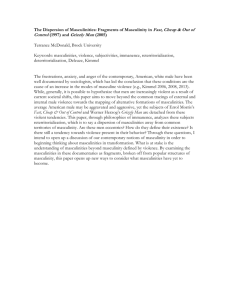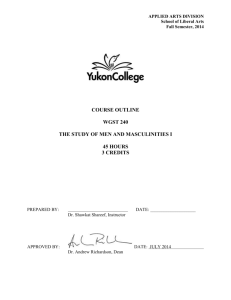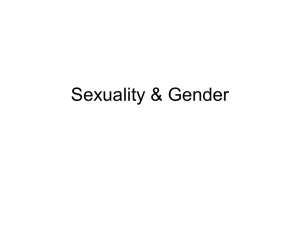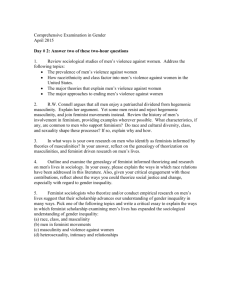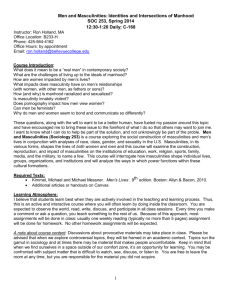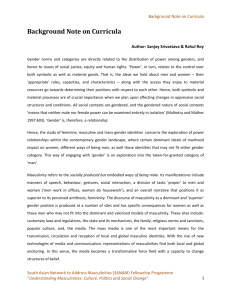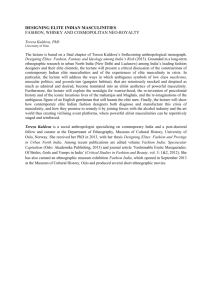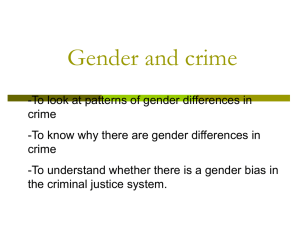Women`s Studies 2115 – FA 2014 Masculinities in a Transnational
advertisement
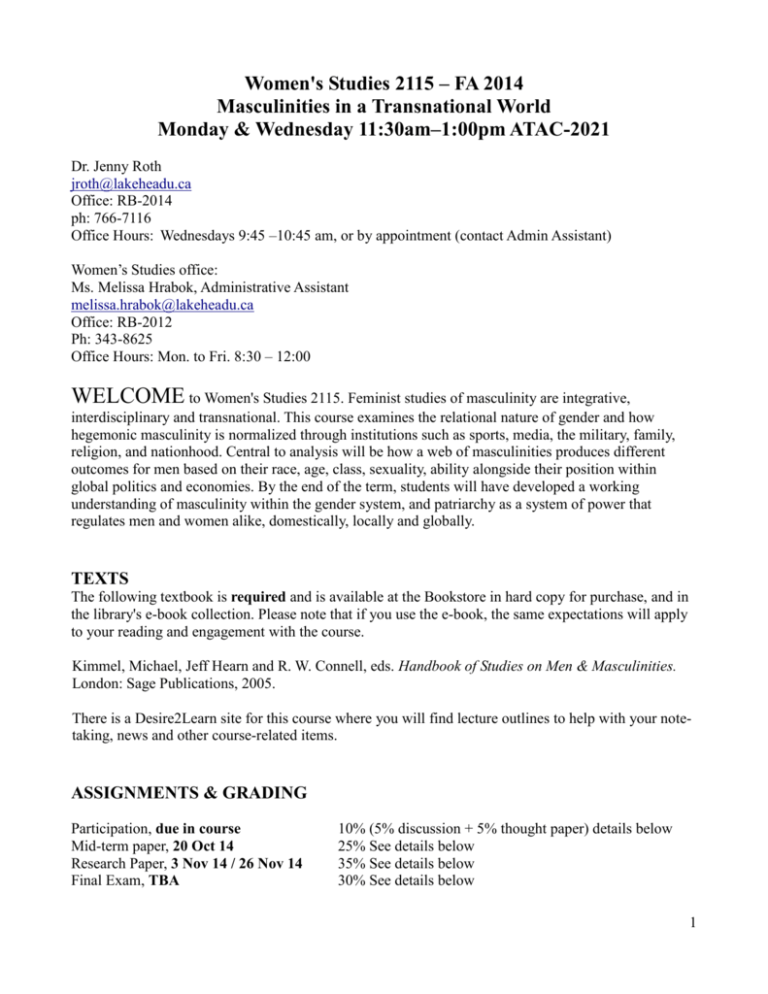
Women's Studies 2115 – FA 2014 Masculinities in a Transnational World Monday & Wednesday 11:30am–1:00pm ATAC-2021 Dr. Jenny Roth jroth@lakeheadu.ca Office: RB-2014 ph: 766-7116 Office Hours: Wednesdays 9:45 –10:45 am, or by appointment (contact Admin Assistant) Women’s Studies office: Ms. Melissa Hrabok, Administrative Assistant melissa.hrabok@lakeheadu.ca Office: RB-2012 Ph: 343-8625 Office Hours: Mon. to Fri. 8:30 – 12:00 WELCOME to Women's Studies 2115. Feminist studies of masculinity are integrative, interdisciplinary and transnational. This course examines the relational nature of gender and how hegemonic masculinity is normalized through institutions such as sports, media, the military, family, religion, and nationhood. Central to analysis will be how a web of masculinities produces different outcomes for men based on their race, age, class, sexuality, ability alongside their position within global politics and economies. By the end of the term, students will have developed a working understanding of masculinity within the gender system, and patriarchy as a system of power that regulates men and women alike, domestically, locally and globally. TEXTS The following textbook is required and is available at the Bookstore in hard copy for purchase, and in the library's e-book collection. Please note that if you use the e-book, the same expectations will apply to your reading and engagement with the course. Kimmel, Michael, Jeff Hearn and R. W. Connell, eds. Handbook of Studies on Men & Masculinities. London: Sage Publications, 2005. There is a Desire2Learn site for this course where you will find lecture outlines to help with your notetaking, news and other course-related items. ASSIGNMENTS & GRADING Participation, due in course Mid-term paper, 20 Oct 14 Research Paper, 3 Nov 14 / 26 Nov 14 Final Exam, TBA 10% (5% discussion + 5% thought paper) details below 25% See details below 35% See details below 30% See details below 1 All assignments will be formatted in: Times New Roman, 12 pt font, double-spaced, with 1-inch margins. Assignments not meeting these format requirements will have 5% deducted from the grade. All assignments will be handed in, in hard copy, at the beginning of the class in which they are due. Any assignment not handed in at the start of class will garner a day’s late penalty. Assignments will be deducted 5% for each day late, including Saturdays and Sundays. Assignments over 7 days late will not be accepted without appropriate documentation. Emailed, faxed, or other forms of assignment will not be accepted. Please do not assume that handing your assignment in at the Women’s Studies office means that I have received it. Make sure I have your assignment when it is due to avoid late penalties. Participation 10% (5% discussion engagement + 5% thought paragraph) Discussion Participation rubric (with thanks to Allegheny College) A grade: You regularly initiate discussion. You come to class thoroughly familiar with the required reading(s) and are prepared to raise questions, open discussion, identify topics of interest, and to actively engage other students in the discussion. Obviously, this does not mean monopolizing the discussion, shutting others down when they contribute, or talking for its own sake. You show respect for topic facilitation, your peers, and clear knowledge about the weeks' reading topics. B grade: You participate regularly and productively. You come to class having done the readings, and willing to engage. You differ from an A-grade discussant in that the latter do not rely on the instructor's questions to set the agenda for discussion. C grade: You participate on a regular basis, though less frequently than a B-grade student. Cgrade discussants' participation may indicate that they are not well-prepared for class, or have not given thought to the assigned materials (e.g.: you speak of personal experience without making connections with the weeks' readings). D grade: You contribute only infrequently to the discussion. D-grade discussants' contributions indicate that they are not well prepared for class, or have not given thought to the assigned materials. F grade: You do not contribute to class discussion OR your participation throughout the term indicates that you have not done the readings or given thought to the topics. Participation is impossible if you are absent. 50% or more absences from the course will mandate an F-grade for participation, inclusive of the written 1-2 paragraph response. Thought Paper A 1-2 paragraph response to one of the readings that you will share with the class. The response will not exceed 1 page, double-spaced and can be given on any day of your choosing to be read at the beginning of class. The response will show an academic engagement with the material, and can connect the personal with the political (but will not merely be a reaction to the week's topic). Mid-term Paper 25% Due Monday, October 20, 2014 3-4 pages, excluding title page and bibliography There are a number of men's groups around the world that challenge and rewrite aspects of local hegemonic masculinity in the pursuit of social justice / equality. Find one! The Gender Issues Centre may be of some help with this assignment. Provide the group's strategies and goals, and analyze why those goals are an important step towards 2 equality within the broader context of patriarchy as a power structure. Remember that patriarchy is connected to class, race, sexual orientation, etc., and show that you have considered those connections when you write this short paper. Remember to cite any paraphrased ideas from the course readings or lectures as you write your paper. Research Paper 35% Topic Proposal for Feedback Due Monday, Nov. 3, 2014 Final Paper Due Wednesday, November 26, 2014 4-6 pages, excluding title page and bibliography Because this class is only long enough to offer an introduction to some of the issues related to boys, men and masculinities, the research paper is an opportunity for you to explore a topic of personal interest in more depth. Choose a real world issue / problem / phenomenon that affects or is related to boys, men, or masculinities, and analyze it using the tools provided to you by the course. You will use a total of at least 5 scholarly readings, 2 of which are from different weeks of the course readings. Your topic proposal for feedback from your peers and me will be discussed in class on Monday, Nov. 3, 2014. At that time, you will break into groups and give each other feedback. I’ll help the groups by providing things to look for in the proposal. I will then collect your proposal, and have it back to you by Monday, November 10, 2014 with brief feedback from me. There is no grade for your proposal, but your paper will be significantly better off because of it. When you prepare your proposal, consider and include: Why does the topic / issue / problem / phenomenon you chose interest you? What is it about the topic that you want to discover or explore? (these first two questions will provide you with the thesis for your paper) Which readings from the course are useful to your topic, and why? (pull some useful quotes out of them for your proposal so that you’re ahead of the game when you begin your writing) Do you need to speak with a reference librarian in order to get help finding the scholarly readings outside the textbook? (if you do, don’t hesitate to ask them – they’re very helpful!) Final Exam 30% Date to be set by Scheduling. Please do not book any tickets or make any travel plans until the exam schedule is released. Exams will not be rescheduled except under circumstances set out in University regulations. Notes on Plagiarism / Academic Dishonesty Keep a printout or photocopy of all your work, as well as any research notes and drafts that produce assignments. “Plagiarism” includes: 1. Plagiarism of ideas occurs where an idea of an author or speaker is incorporated into the body of an assignment as though it were the writer's own idea, no credit is given the person through 3 citation. 2. Plagiarism of words occurs when phrases, sentences, tables or illustrations of an author or speaker are incorporated without citation. 3. Plagiarism of ideas and words occurs where words and an idea(s) of an author or speaker are incorporated into the body of a written assignment as though they were the writers' own words and ideas without citation. The following rules shall govern the treatment of candidates who have been found guilty of attempting to obtain academic credit dishonestly. (a) The minimum penalty for a candidate found guilty of plagiarism, or of cheating on any part of a course will be a zero for the work concerned. (b) A candidate found guilty of cheating on a formal examination or a test, or of serious or repeated plagiarism, or of unofficially obtaining a copy of the examination paper before the examination is scheduled to be written, will receive zero for the course and may be expelled from the University. A copy of the “Code of Student Behaviour and Disciplinary Procedures” including sections on plagiarism and other forms of misconduct may be obtained from the University's website, or from the Office of the Registrar. Learning Needs If you have needs regarding the format or the due dates for the readings or assignments, you must make sure that I am informed. The appropriate form can be obtained from the Student Success Centre. Class Expectations, alongside the Student Code of Conduct You can expect from me that: I will provide you with feedback on rough drafts that I receive one week prior to the due date, if you want to provide them; I will stick to the course outline; I will encourage your learning, and support you in an inclusive and intellectually dynamic environment; I will hand back assignments two weeks after their due date; I will provide you with a mid-term participation estimate when I hand back your mid-term essay based on your work in the first half of the course; I will be available during my posted office hours to discuss any aspect of the course, and to answer more general questions you may have about the university system; I will check my work email during regular work hours (8:30 am – 4:30 pm), and will respond to your email as soon as I can during those times; I will do my best to give you enough information to succeed in this course. I will expect from you that: You will speak to me during office hours when you have questions about the course, the materials, your assignments, or your program; You will be in the classroom, ready to begin at 11:30; You will respect social and cultural differences. All participants have the right to hold, defend, 4 and promote their opinion, but this right exists alongside regulations that protect all individuals' right to education without discrimination or harassment on the basis of gender, race, religion, class, sexual orientation, ability, age, place of origin, etc.; You will respect differences in political awareness and educational development. Use of tech for purposes other than note-taking or text book referencing Please feel free to use your technology as you will, so long as it doesn’t disturb those around you. If your use of technology disturbs the classroom environment in any way, including distracting me or your peers, you are in breach of the Student Code of Conduct, and will lose your tech privileges in the classroom for the duration of the course – no exceptions. Please note that if you choose to use technology for anything other than the class-related purposes of note-taking or consulting the textbook online, I will not discuss with you any concerns you may have about your course grades. I offer my support to students who are at all times fully engaged with the course. Weekly Topics & Readings Wk. 1: Sept. 8 / 10 Introduction to the Course Readings: None this week, welcome! Goals: Define “transnational”: the foundations for our course Define “hegemonic masculinity” using a transnational perspective: more foundations Film: Tough Guise 2 and discussion on how to recognize and analyze hegemonic masculinity in the dominant North American context, leading into other contexts Move from analysis of TG2 to consider gender as a system of signs Wk. 2: Sept. 15 / 17 Why Study Masculinities? Readings: Gullvåg Holter, Øystein. “Social Theories for Researching Men and Masculinities: Direct Gender Hierarchy and Structural Inequality” pp. 15-34. Kegan Gardiner, Judith. “Men, Masculinities, and Feminist Theory” pp. 35-50. Flood, Michael. “Men’s Collective Struggles for Gender Justice: The Case of Antiviolence Activism” pp. 458-466. Goals: Define “structural inequality” and “gender hierarchy” Define “masculinity” Understand how masculinity works in opposition to femininity to shape men's lives Bring examples of the social construction of masculinity to class. Wk. 3: Sept. 22 / 24 Web of Masculinities – Transnational Contexts I Reading(s): Connell, R. W. “Globalization, Imperialism, and Masculinities” pp. 71-89. Morrell, Robert and Sandra Swart. “Men in the Third World: Postcolonial Perspectives on 5 Masculinity” pp. 90-113. Gutmann, Matthew and Mara Viveros Vigoya. “Masculinities in Latin America” pp. 114-128. Goals: Define “web of masculinities” Define “patriarchy” within the context of past and present imperialism(s) Understand how masculinities are currently shaped by past and present imperialism(s) Bring examples of how masculinities are shaped by globalization or imperial pressures; please don’t revert to racist, classist, homophobic, ageist, ethnocentric or other stereotyping in your examples Wk. 4: Sept. 29 / Oct. 1 Web of Masculinities – Transnational Contexts II Reading(s): Taga, Futoshi. “East Asian Masculinities” pp. 129-140. Critical Research on Men in Europe (CROME). “Men, Masculinities, and 'Europe'” pp. 141162. Gerami, Shahin. “Islamist Masculinity and Muslim Masculinities” pp. 448-457. Goals: Apply last week's definitions and knowledge to the evidence in this week's readings Understand that masculinity is not a fixed, natural, biologically inevitable phenomenon Note in the readings how masculinities differ cross-culturally; note how global power structures affect local masculinities Bring an example of how Canadian masculinities are shaped by transnationalism Wk. 5: Oct. 6 / 8 Nation, War and Masculinities Reading(s): Nagel, Joane. “Nation” pp. 397-413. Kimmel, Michael S. “Globalization and Its Mal(e)contents: The Gendered Moral and Political Economy of Terrorism” pp. 414-431. Higate, Paul and John Hopton. “War, Militarism, and Masculinities” pp. 432-447 Goals: Define “nation” within the context of transnationalism Understand how masculinity constructs and is constructed by “nation” Note the connections between masculinity (gender construct), war and militarism Bring an example of how Canadian nationhood or military foreign policy is framed by masculinity. Wk. 6: Oct. 13 / 15 Social Institutions I: Law & Education Reading(s): Messerschmidt, James. “Men, Masculinities, and Crime” pp. 196-212. Swain, Jon. “Masculinities in Education” pp. 213-229. Goals: Review expectations for short mid-term paper Define “oppression” Define “institution” Understand how social institutions affect boys’ and men’s lives differently Bring examples of how social institutions work to produce different masculinities. Wk. 7: Oct. 20 / 22 Social Structures: Work, Money and Classism 6 **Mid-term essay due Monday, Oct. 20** Reading(s): Morgan, David. “Class and Masculinity” 165-177. Collinson, David and Jeff Hearn. “Men and Masculinities in Work, Organizations, and Management” pp. 289-310. Goals: Define “social location” Define “integrative analysis” Note in the readings and understand how social structures affect boys’ and men’s lives differently Bring examples of how social structures work to produce different masculinities. \ Wk. 8: Oct. 27 / 29 Social Institutions II: Family Life Reading(s): Adams, Michele and Scott Coltrane. “Boys and Men in Families: The Domestic Production of Gender, Power, and Privilege” pp. 230-248. Marsiglio, William and Joseph Pleck. “Fatherhood and Masculinity” pp. 270-288. DeKeseredy, Walter and Martin Schwartz. “Masculinities and Interpersonal Violence” pp. 353366. Goals: Define “family” Understand how “family” works as a cultural institution Consider the home as one of the first points of gender construction Bring examples of how masculinity was constructed in your home (if applicable), or what you observed in friends’ homes (if applicable). Wk. 9: Nov. 3 / 5 Sports, Health & Masculinity **Research paper topic proposal is due Monday in class** Reading(s): Messner, Michael. “Still a Man’s World? Studying Masculinities and Sport” pp. 313-325 Sabo, Don. “The Study of Masculinities and Men’s Health: An Overview” pp. 326-352. Goals: Small-group feedback on your Research Paper Proposal Define “health” as an institution and as a vehicle for ideology Understand how male bodies are constructed, sculpted and normalized by discourses of health and sports Bring examples of the ways masculine bodies are currently being normalized in sports and health. Wk. 10: Nov. 10 / 12 Social Institutions III: Media & Masculine Bodies Reading(s): McKay, Jim, Mikosza, Janine and Brett Hutchins. “‘Gentlemen, the Lunchbox has Landed’: Representations of Masculinities and Men’s Bodies in the Popular Media” pp. 270-288. Gerschick, Thomas. “Masculinity and Degrees of Bodily Normativity in Western Culture” pp. 367-378. Goals: Define “media” as institution Define “body” as a product of ideology 7 Understand how male bodies are constructed, sculpted and normalized by media Bring examples of the ways masculine bodies are currently being normalized in media. Wk. 11: Nov. 17 / 19 Queer Masculinities – Challenging the Binary & Biological Determinism Readings: Edwards, Tim. “Queering the Pitch? Gay Masculinities” pp. 51-68 Plummer, Ken. “Male Sexualities” pp. 178-195 Ekins, Richard and Dave King. “Transgendering, Men, and Masculinities” pp. 379-394. Film: Behind the Queen Goals: Connect the notes and knowledge you have from Week 2 to this week's readings Understand how patriarchy relies on a binary 2-gender system; be able to give examples in relation to queer masculinities and systems of power Consider the role of surveillance, coercion, and control between men to regulate masculinitiy Notice how queer masculinities are “othered” and make connections between systems of “othering” within transnational and patriarchal power structures. Wk. 12: Nov. 24 / 26 Active Exam Review **Research Paper Due Wednesday, Nov. 26** Goals: Prepare group-driven synopses for each week (bring all of the notes you have taken this term) Prepare a list of useful quotes from the text to support each week's theme Bring any questions you might still have 8
